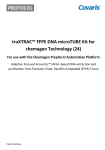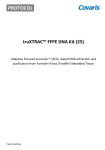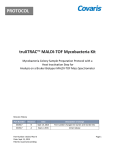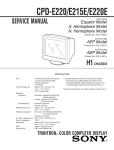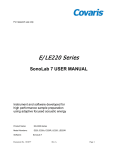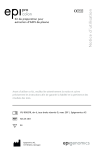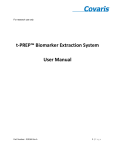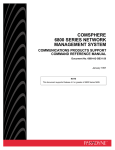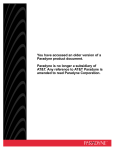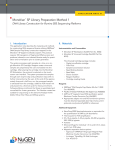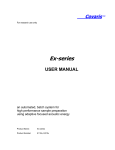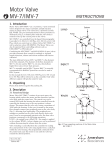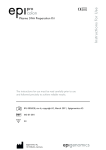Download truXTRAC FFPE DNA 8 microTUBE Strip Kit for chemagen
Transcript
PROTOCOL truXTRAC™ FFPE DNA 8 microTUBE Strip Kit for chemagen Technology (96) Adaptive Focused Acoustics™ (AFA) -based DNA extraction and purification from Formalin-Fixed, Paraffin-Embedded (FFPE) Tissue Contents INTENDED USE ........................................................................................................................................... 2 INTRODUCTION .......................................................................................................................................... 2 REVISION HISTORY ...................................................................................................................................... 3 KIT CONTENTS............................................................................................................................................ 3 STORAGE ................................................................................................................................................... 3 SUPPLIED BY USERS ..................................................................................................................................... 3 PROCEDURE WORKFLOW OVERVIEW ............................................................................................................. 5 1 - PREPARATION........................................................................................................................................ 7 FFPE Tissue Sample ............................................................................................................................ 7 Buffer.................................................................................................................................................. 8 Instruments ........................................................................................................................................ 8 Prepare Heating Block ........................................................................................................................ 9 PerkinElmer chemagic Prepito®-D ..................................................................................................... 9 2 - DNA EXTRACTION FROM FFPE TISSUE ..................................................................................................... 10 APPENDIX A – EXAMPLES OF DNA FRAGMENTS SIZE DISTRIBUTION ................................................................... 16 APPENDIX B – EXAMPLE OF PARAFFIN EMULSIFICATION WITH AFA ENERGY ........................................................ 17 APPENDIX C – TROUBLESHOOTING GUIDE..................................................................................................... 18 APPENDIX D – COVARIS HEAT BLOCK NOMINAL DIMENSIONS .......................................................................... 19 APPENDIX E – DRY BLOCK HEATER CALIBRATION PROCEDURE .......................................................................... 19 Part Number: 010295 Rev A July 2015 Patents Granted and Pending 1|P a g e INTENDED USE The truXTRAC FFPE DNA Kit is intended for use in molecular biology applications. This product is not intended for the diagnosis, prevention, or treatment of a disease. INTRODUCTION The truXTRAC FFPE DNA Kit for chemagen Technology is designed for the efficient extraction of DNA from Formalin Fixed, Paraffin Embedded (FFPE) tissue samples with Covaris Adaptive Focused Acoustics (AFA™) and subsequent purification with PerkinElmer chemagen Technology. The process results in high yields of high-quality DNA well suited for analytical methods such as next-generation sequencing or qPCR. AFA enables effective removal of paraffin from FFPE tissue samples in aqueous buffer, with simultaneous tissue rehydration. Compared to chemical-based methods of paraffin removal, this mechanical process is not as limited by the thickness of FFPE tissue sections. The ability to use thicker sections can increase DNA yield and minimize the impact of increased DNA degradation at the exposed surfaces of a section. This protocol is optimized for sections up to 25 µm in thickness and cores up to 1.2 mm in diameter. Important Notes on FFPE Samples: The yield of DNA from FFPE tissue blocks is highly variable. Factors such as fixation time, size and thickness of the sections, the ratio of tissue to wax, the type of tissue, and the age of the FFPE block are the main causes for this variability. The quality of DNA isolated from FFPE samples depends on many of the same factors and is thus also highly variable. During the fixation process, DNA is cross-linked to proteins and other nucleic acid molecules to varying degrees. Incomplete reversal of this crosslinking may cause the isolated DNA to perform less well in downstream enzymatic applications such as qPCR. In addition, the size of DNA fragments isolated from FFPE samples is generally smaller than that of DNA isolated from fresh or frozen tissues. This is particularly evident in older FFPE sample blocks or sample blocks stored at elevated temperatures. Note for first time users: Given the highly variable yield of DNA from FFPE tissue blocks, we recommend using FFPE blocks that have been well characterized for yield and quality for initial testing of the truXTRAC FFPE kit. Ideally, samples should be extracted immediately after sectioning. Please contact Covaris at Application Support ([email protected]) if you have any questions. Part Number: 010295 Rev A July 2015 Patents Granted and Pending 2|P a g e REVISION HISTORY Part Number Revision Date Description of change 010295 A July 2015 Initial release KIT CONTENTS Tissue SDS Buffer PK Solution 8 microTUBE-130 AFA Fiber Uncapped Strip V2 10 ml 2x 1.25 ml 12 SDS information available at http://covarisinc.com/resources/safety-data-sheets/ STORAGE This kit should be stored at room temperature (18 – 25 °C). SUPPLIED BY USERS Covaris Instruments and Parts Required parts Focusedultrasonicator Rack/ Holder/ Insert Accessories LE220 E220 & E210 E220 evolution Rack-XT 12 Place 8 microTUBE Strip V2 (PN500485) Rack 12 Place 8 microTUBE Strip V2 (PN500444) Rack E220e 8 microTUBE Strip V2 (PN500437) Heat Block Rack 12 Place 8 microTUBE Strip V2* (PN500481) (x2) Heat Block Rack E220e 8 microTUBE Strip V2* (PN500493) (x2) *Referred to as Covaris Heat Block in text. Cap Press Tool 8 microTUBE Strip V2 (PN 500469) Chemagen Kit Prepito truXTRAC DNA FFPE Kit (CMG-2037) Optional parts Accessories Part Number: 010295 Rev A July 2015 Patents Granted and Pending FFPE tissuePICK (PN 520163) FFPE sectionPICK (PN 520149) FFPE sectionWARMER (PN 500403) 3|P a g e • • PerkinElmer chemagic Instruments and Parts chemagic Prepito-D or equivalent Prepito truXTRAC DNA FFPE Kit (CMG-2037) Other supplies: • Dry block heater (eg, from VWR) with at least two-blocks capacity. We recommend two dry block heaters, preset at T set1 and T set2 respectively. See Appendix D and E for nominal dimensions of the Covaris Heat Block and calibration procedure. • RNase A (DNase free) at 10 mg/ml e.g., Thermo Scientific (PN EN0531) Part Number: 010295 Rev A July 2015 Patents Granted and Pending 4|P a g e PROCEDURE WORKFLOW OVERVIEW Three different protocols are supported for the Covaris truXTRAC FFPE DNA Kit. The three options have different DNA extraction workflows. The DNA purification workflow is identical for all three options. Option A: Shear DNA during extraction to a size suitable for next-generation sequencing library construction. Fragment size can be tuned between 200 and 400 bp. Option B: Extract ~2kb DNA fragments. This protocol is recommended for most analytical applications, including PCR. Note that actual DNA fragment size will depend of the quality of the starting material. Option C: Extract large “genomic” DNA without any additional fragmentation. Actual DNA fragment size will depend on the quality of the starting material. For high-quality FFPE tissue blocks, we typically see an average fragment size of >= 8 kb. Please refer to Appendix A for examples of final DNA fragment size distribution. OPTION A – EXTRACT AND FRAGMENT DNA (FOR NGS) Part Number: 010295 Rev A July 2015 Patents Granted and Pending 5|P a g e OPTION B - EXTRACT LARGE DNA FRAGMENTS (>2 KB)* WITH IMPROVED YIELD * Actual DNA fragment size will depend of the quality of the starting tissue block OPTION C - EXTRACT “GENOMIC” DNA* * Actual DNA fragment size will depend of the quality of the starting tissue block Part Number: 010295 Rev A July 2015 Patents Granted and Pending 6|P a g e 1 - PREPARATION FFPE Tissue Sample 1. Sample Input requirements The truXTRAC process is highly efficient at removing paraffin even from relatively thick FFPE sections while simultaneously rehydrating the tissue. Use of thicker sections is often desirable, both for increased yield and since DNA or RNA in the exposed surfaces of a section tends to degrade quickly. We recommend using sections between 15 and 25 µm thick, or cores of 1.2 mm. IMPORTANT: Excess paraffin will adversely affect the yield and quality of DNA and RNA extracted from FFPE. We strongly advise trimming off any excess of paraffin before sectioning a FFPE tissue block, or after the section has been cut from the FFPE block. A ratio of 80% tissue to 20% paraffin or higher is ideal. The total mass of FFPE sample processed per extraction should be between 2 to 5 mg. Lower amounts may result in insufficient yield. Size (thickness or diameter) FFPE Sections FFPE Sections Mounted on slide “scrolls” or “curls” 4 to 10 µm 7 to 10 µm 16 to 25 µm < 1.2 mm diameter <10 mm (if longer, cut in half before loading) NA Size (length) 7 to 15 µm FFPE Cores Collection tool tissuePICK sectionPICK Maximum number of TRIMMED samples Per Tube 2x tissuePICK (200 mm2 tissue for a 5 µm section) 2x sectionPICK NA 2 1 1 NOTE: For optimal tissuePICK and sectionPICK performances, tissue section should be mounted on uncoated slides. The tissuePICK and sectionPICK should always be used in conjunction with a sectionWARMER. Part Number: 010295 Rev A July 2015 Patents Granted and Pending 7|P a g e 2. Tissue Fixation Requirements The yield and quality of DNA extracted from FFPE tissue blocks is highly dependent on tissue collection and paraffin embedding procedures. For good yields of high quality DNA: - Use a maximum fixation time of 24 hours. - Use Formalin solution, neutral buffered, 4%. - Fix sample tissue sample as quickly as possible after collection. Buffer 1. Check Tissue SDS Buffer: A white precipitate may form during storage. Incubate the bottle at 50 – 70 °C before use to dissolve any precipitate. Instruments NOTE: For detailed instructions on how to prepare your particular instrument, please refer to your instrument’s User Manual. 1. For E and LE-Series Focused-ultrasonicators, fill the water bath, set the chiller temperature as described in Table 1, and allow the system temperature to equilibrate and the water bath to degas. - For E210 or E220, load the plate definition “E220_500444 Rack 12 Place 8 microTUBE Strip V2 -1.5mm offset” and check that the intensifier is in place. - For E220 evolution load the plate definition “500437 Rack E220e 8 microTUBE Strip V2 6mm offset” and check that the intensifier is in place. - For LE-Series: Load the plate definition “LE220_500485 Rack-XT 12 Place 8 microTUBE Strip V2 -1.5mm offset.” NOTE: If you do not see the correct plate definition on your system, please contact Covaris technical support at [email protected]. Table 1 - Focused-ultrasonicator setup Instrument E-Series & L-Series Part Number: 010295 Rev A July 2015 Patents Granted and Pending Water level (Fill/RUN scale) Chiller temperature 6 18°C 8|P a g e Prepare Heating Block Dry block heaters should be preset at T set1 and T set2. See Appendix D and E for instructions on how to calibrate and install the Covaris Heat Blocks. PerkinElmer chemagic Prepito®-D Please refer to the chemagic Prepito-D instrument user manual (revision 2022-0020) Part Number: 010295 Rev A July 2015 Patents Granted and Pending 9|P a g e 2 - DNA EXTRACTION FROM FFPE TISSUE 1. Using Table 2 below as a guide, generate the Processing Buffer master mix by mixing Tissue Lysis Buffer and Proteinase K. Table 2 – Processing Buffer master mix Number of samples 8 16 x Tissue SDS Buffer volume 704 µl 1408 µl x * 88 µl Proteinase K volume 176 µl 352 µl x * 22 µl 2. Carefully peel off the blue tape from the 8 microTUBE 130 Strip and remove the Cap Strip. Keep 8 microTUBE-130 Strip upright while handling, to avoid losing the tube insert! 3. Load the 8 microTUBE-130 Strip (without Cap Strip) into the Cap Press Tool as shown. 4. Add 100 µl Processing Buffer master mix into each microTUBE and load FFPE tissue (section or core). Part Number: 010295 Rev A July 2015 Patents Granted and Pending 10 | P a g e NOTE: if the FFPE tissue samples are loose or broken, the samples may be added to the microTUBE prior to Processing Buffer addition to facilitate easier loading. 5. Place the Cap Strip on top of the 8 microTUBE-130 Strip, with the white side facing up. 6. Close the Cap Press Tool and apply pressure until the lever bottoms out, snapping the Cap Strip into place. Lift the Cap Press Tool and make sure that the Cap Strip is level. 7. Load 8 microTUBE-130 Strip into Rack. Part Number: 010295 Rev A July 2015 Patents Granted and Pending 11 | P a g e 8. Repeat steps 2 to 7 until all samples have been loaded. 9. Close the Rack using the screws affixed to the cover. 10. Process the sample using the settings provided in Table 3 below to dissociate the paraffin while simultaneously rehydrating the tissue. (Please see the example in Appendix B.) During the AFA process, it is normal for the solution to turn milky white as the paraffin is emulsified. NOTE: Processed samples are stable for up to 8 hours while remaining samples are treated. Table 3 - Paraffin removal and tissue rehydration settings System E220 E210 LE220 Duty Factor 10% 10% 20% Peak Incident Power 175 Watts 5 (Intensity) 450 Watts (1) Cycles per burst 200 200 200 Treatment Temperature Time (Instrument) 300 sec 20 °C 300 sec 20 °C 300 sec 20 °C (1) Since PIP is distributed across multiple microTUBEs in an LE220, the power received by individual microTUBE stays within the 200 W limit. 11. Protein digestion at T set1 IMPORTANT: Use a Covaris Heat Block inside the dry block heater (instead of a standard heat block for microfuge tubes). Calibrate the dry block heater before use (see Appendix E for instructions). Failure to calibrate the dry block heater may lead to incomplete tissue digestion and/or incomplete crosslink reversal. Part Number: 010295 Rev A July 2015 Patents Granted and Pending 12 | P a g e a. Insert a Covaris Heat Block into a dry block heater set at temperature T set1. b. Once T set1 has been reached, load the rack containing the samples into the Covaris Heat Block. c. An incubation time of 1 hour at T set1 is sufficient for sections 10 µm or less in thickness; 12-hour (i.e. overnight) incubation should be used for larger samples, such as 25 µm sections and cores. If the digestion is incomplete after 12 hours, add an additional 20 µl of Proteinase K solution, mix, and incubate for 1 more hour. 12. Incubate the samples at T set2 for 1 hour to reverse formaldehyde crosslinks. a. Insert a Covaris Heat Block into a dry block heater set at temperature T set2. (If using the same dry block heater for both the T set1 & T set2 incubations, the rack containing the samples should be stored at room temperature until the Covaris Heat Block reaches T set2.) Once T set2 has been reached, load the rack containing the samples into the Covaris Heat Block. 13. For Option C “ Extract Genomic DNA” Proceed to Section 3 – DNA Purification 14. For Option B, “Extract large DNA Fragments (>2 kb) with Improved yield”, process the samples using the settings in Table 4 below to release the DNA with AFA and proceed to Section 3 – DNA Purification with Prepito. Part Number: 010295 Rev A July 2015 Patents Granted and Pending 13 | P a g e Table 4 – DNA release with AFA System E220 E210 LE220 Duty Factor 10% 10% 30% Peak Incident Power 105 Watts 3 (Intensity) 300 Watts (1) Cycles per burst 200 200 200 Time 10 sec 10 sec 10 Sec Temperature (Instrument) 20 °C 20 °C 20 °C 15. For Option A, “Extract and Fragment DNA (for NGS)”, process the samples using the appropriate settings in Table 5 below for the desired DNA fragment size, then proceed to Section 3 – DNA Purification with Prepito NOTE: If the target size is not achieved using the settings shown in Table 5, the treatment time should be adjusted. Table 5 - DNA Shearing settings E- Series Focused-ultrasonicator Targeted fragment size 200 bp 300 bp 400 bp Treatment Time 300 sec 110 sec 80 sec PIP (E220) 175 W 175 W 175 W 5 5 5 Duty Factor 10% 10% 10% Cycle per Burst Temperature 200 20 °C 200 20 °C 200 20 °C Intensity (E210) LE220 Focused-ultrasonicator Targeted fragment size Treatment Time PIP Duty Factor Cycle per Burst Temperature Part Number: 010295 Rev A July 2015 Patents Granted and Pending 200 bp 450 sec 450 W 20% 200 20 °C 300 bp 225 sec 450 W 20% 200 20 °C 400 bp 120 sec 450 W 20% 200 20 °C 14 | P a g e 3 - DNA PURIFICATION WITH CHEMAGEN TECHNOLOGY This step requires the Prepito truXTRAC DNA FFPE Kit (CMG-2037) and associated script. 1. Place the rack with the samples on a Covaris Heat Block set at T set1 to prevent paraffin from solidifying. (If amounts of emulsified paraffin are small, it may be possible to keep the samples at room temperature.) 2. Transfer the FFPE lysates to the first row of a 96 well Deep Well Plate (DWP - included in the Prepito truXTRAC DNA FFPE Kit). Sample should be retrieved by pipetting through the septum. For easy pipetting of sample in a single step, we recommend using pipette tips with ribs (e.g., Hamilton 250 µl Ribbed Tip or Agilent Bravo 250 µl Tip). Otherwise, two pipetting steps with 50 µl tips may be necessary. 3. Optional: The sample can be treated with RNase A to remove RNA before DNA purification. Add 5µl of RNase A solution to the FFPE lysate and incubate for 5 minutes at room temperature. 4. Follow Prepito truXTRAC DNA FFPE Kit instructions to purify the DNA. Part Number: 010295 Rev A July 2015 Patents Granted and Pending 15 | P a g e APPENDIX A – EXAMPLES OF DNA FRAGMENTS SIZE DISTRIBUTION Multiple 10 µm sections were cut off the same FFPE kidney tissue block, and DNA was extracted with the Covaris FFPE kit using Option A, B, or C. Extracted DNA was purified and analyzed on a Bioanalyzer. The size of the non-fragmented, genomic DNA (Option C) depends on how the tissue block was generated and stored as well as the age of the tissue block. 200, 300 and 400 bp Peaks Option A Extract and fragment DNA (for NGS) After extraction, DNA was sheared to a size suitable for NGS library construction. In this example, one sample was sheared to 200 bp, one to 300 bp, and one to 400 bp. 3 kb Peak Option B Extract large DNA fragments (>2 kb)* After extraction, AFA energy was used to increase DNA release from the tissue. During this process, the DNA was also sheared into fragments larger than 2 kb. *Final size will depend of the quality of the starting tissue. Option C Extract genomic DNA* 8 kb Peak No additional AFA energy was applied after extraction. DNA size will be the largest possible. *Final size will depend of the quality of the starting tissue Part Number: 010295 Rev A July 2015 Patents Granted and Pending 16 | P a g e APPENDIX B – EXAMPLE OF PARAFFIN EMULSIFICATION WITH AFA ENERGY Paraffin was emulsified in a microTUBE Screw-Cap using a Covaris S220 Focused-ultrasonicator. Sample before (left side) and after (right side) processing. Sample was a 10 μm kidney tissue section. Part Number: 010295 Rev A July 2015 Patents Granted and Pending 17 | P a g e APPENDIX C – TROUBLESHOOTING GUIDE Issue Low yield of DNA Cause Solution Comments / Suggestions Low tissue to wax ratio in FFPE section. Repeat the procedure using additional sections until desired yield is achieved. In your initial use of the truXTRAC FFPE kit, use FFPE blocks that have been well characterized for yield and quality. Proteinase K stored above recommended temperature or expired. Repeat the procedure using fresh Proteinase K. Always store proteinase K solution at Room Temperature or 4°C. DNA does not perform well in downstream applications such as qPCR DNA in FFPE sample blocks is severely crosslinked or degraded. Design amplicons to be as small DNA isolated using Covaris AFA technology is of the as possible (<100 bp). highest possible quality. Some FFPE sample blocks may be too degraded or cross-linked for some applications. DNA fragment size too large when following Option A Too much emulsified paraffin in the sample Trim any excess paraffin from tissue blocks before proceeding with protocol. If it isn’t possible to completely trim the paraffin from the FFPE block, we recommend running a treatment time course by increasing the treatment time by 30 seconds steps. Too much emulsified paraffin absorbs some of the acoustic energy and will adversely affect DNA shearing efficiency. Low yield for NGS library construction or by qPCR Incomplete crosslink reversal Check that dry block heater was calibrated following procedure in Appendix E Incomplete crosslink reversal will prevent DNA amplification Part Number: 010295 Rev A July 2015 Patents Granted and Pending 18 | P a g e APPENDIX D – COVARIS HEAT BLOCK NOMINAL DIMENSIONS Heat Block Rack 12 Place 8 microTUBE Strip V2 (PN 500481) (referred to as Covaris Heat Block in text) (in millimeters) Hole for glass thermometer APPENDIX E – DRY BLOCK HEATER CALIBRATION PROCEDURE 1. Place the Covaris Heat Block into the dry block heater. 2. Add water to the separate hole in the Covaris Heat Block and insert a glass thermometer. 3. Set the dry block heater temperature to 60˚C. 4. Wait for the dry block heater to reach the set point. 5. Check temperature displayed by the thermometer (Tth). 6. If Tth is between 59˚C and 61˚C (setpoint +/- 1 ˚C), use 60˚C for Tset1. 7. Otherwise, use the formula below to obtain T set1: T set1 (˚C) = 120˚C- Tth 8. Repeat steps 3-7 with an initial set point of 90˚C to obtain T set2: T set2 (˚C) = 180˚C- Tth Part Number: 010295 Rev A July 2015 Patents Granted and Pending 19 | P a g e Additional Notes 1. Covered by US Patent 9,080,167 2. Other patents pending 3. Best Practices for determining the yield and purity of isolated DNA: • To determine DNA yield with the highest level of accuracy, a fluorometric assay such as Qubit TM (Life Technologies) should be used. • In addition, spectrophotometric analysis of DNA for A260/280 and A260/230 ratios will determine if protein or peptide/salt contamination is present in the sample. 4. Tissue Blocks were obtained from: Theresa Kokkat, PhD and Diane McGarvey, Cooperative Human Tissue Network (CHTN), Eastern Division, University of Pennsylvania, USA 5. See following link: http://covarisinc.com/wp-content/uploads/pn_010295.pdf for updates to this document. 6. The treatment settings listed in this document are recommended guidelines. Actual results may vary depending on the tissue type, mass, and previous handling of FFPE samples. Part Number: 010295 Rev A July 2015 Patents Granted and Pending 20 | P a g e






















